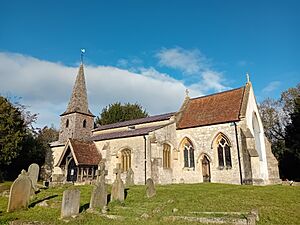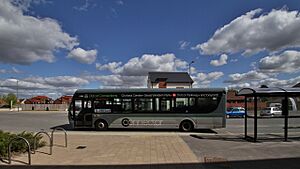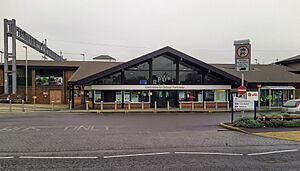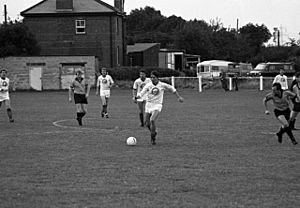Didcot facts for kids
Quick facts for kids Didcot |
|
|---|---|
| Town | |
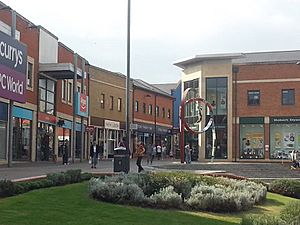 Didcot town centre, including the modern art installation The Swirl |
|
| Area | 8.48 km2 (3.27 sq mi) |
| Population | 32,183 (2021 Census) |
| • Density | 3,795/km2 (9,830/sq mi) |
| OS grid reference | SU525900 |
| • London | 54.7 mi (88.0 km) |
| Civil parish |
|
| District | |
| Shire county | |
| Region | |
| Country | England |
| Sovereign state | United Kingdom |
| Post town | Didcot |
| Postcode district | OX11 |
| Dialling code | 01235 |
| Police | Thames Valley |
| Fire | Oxfordshire |
| Ambulance | South Central |
| EU Parliament | South East England |
| UK Parliament |
|
| Website | Didcot Town Council |
Didcot (/ˈdɪdkɒt, -kət/ DID-kot-,_--kət) is a town in South Oxfordshire, England. It's about 15 miles (24 km) south of Oxford. Didcot is famous for its railway history. The station opened in 1844 and became a major railway hub.
Today, Didcot is known for its railway museum and its connection to the Science Vale. This area has big science and technology centers in nearby villages like Milton, Culham, and Harwell. These centers include places like the Rutherford Appleton Laboratory.
Contents
History of Didcot
Early Times
People have lived around Didcot for at least 9,000 years. Digs between 2010 and 2013 found items from the Stone Age and Bronze Age. During Roman times, people tried to drain marshy land here. In 1995, a collection of 126 gold Roman coins from around 160 AD was found nearby. You can see these coins at the Ashmolean Museum.
The name Didcot comes from an old English word meaning "Dudda's people's house." It might be linked to Dida, a 7th-century ruler in the Oxford area.
Didcot was a small village for many centuries. It was much smaller than nearby villages like Harwell. The oldest parts of the Church of England parish church of All Saints date back to the 12th century.
The Arrival of Railways
Parts of the old village still exist around All Saints' church. In the 1500s, Didcot was a small village with about 120 people. The oldest house still standing is White Cottage, built in the 16th century.
Didcot was on a toll road between London and Wantage. People had to pay to use this road until 1879.
Great Western Railway
The Great Western Railway, designed by Isambard Kingdom Brunel, reached Didcot in 1839. The Didcot station opened in 1844. The railway helped Didcot grow a lot.
Didcot, Newbury and Southampton Railway
Didcot became important during the First World War and Second World War. This was because it was a railway junction connecting London, Bristol, Oxford, and Southampton. The Didcot, Newbury and Southampton Railway (DN&S) line, which went to Southampton, is now closed.
During World War II, the DN&S line was very busy with military traffic. It was even made into a double track to handle more trains. Passenger trains stopped using this line in 1962, and it was fully closed in 1966. Today, part of the old railway path is a Sustrans route for walking and cycling.
Didcot Today
Didcot's population grew to over 31,000 by 2021. A new town center, the Orchard Centre, opened in 2005. Didcot is part of the Science Vale, which has many large science and technology centers nearby. These include the Culham Science Centre and Harwell Science and Innovation Campus. The Diamond Light Source at Harwell is a huge scientific facility.
Didcot is a major growth area in Oxfordshire. New housing developments like Ladygrove and Great Western Park have greatly increased the number of homes.
In 2008, a new arts center called Cornerstone opened. In 2015, Didcot was named a "garden town" by the UK government. This means it gets funding for sustainable and eco-friendly development. In 2017, researchers even called Didcot the most "normal" town in England!
Railways in Didcot
Didcot Railway Centre
The Didcot Railway Centre was started in 1967 by the Great Western Society. It keeps a collection of old Great Western Railway trains. The center is often used for filming movies like Anna Karenina and The Elephant Man. You can get to it from Didcot Parkway railway station.
Didcot Parkway Station
The station was first called Didcot. In 1985, it was renamed Didcot Parkway. A large car park was built to help people from nearby areas use the train. The station forecourt was also improved starting in 2012.
Didcot's Economy
Power Stations

Didcot A Power Station stopped making electricity in 2013. Its tall cooling towers were a famous sight, visible from far away.
In 2010, Didcot Sewage Works became the first in the UK to produce biomethane gas for the National Grid. This gas can power up to 200 homes.
Three of the six cooling towers were taken down in 2014 using explosives. In 2016, part of the power station building collapsed. Sadly, some people were killed or went missing. The rest of the building was later taken down in a controlled explosion. The last three cooling towers were demolished in 2019.
Motor Racing
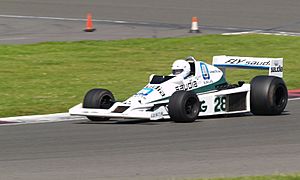
Didcot has a strong link to motorsports. The Williams Grand Prix Engineering team, famous in Formula One, started here in 1977. They later moved to a new factory in Didcot before moving to nearby Grove. A road in Didcot, Sir Frank Williams Avenue, is named after the team's founder.
Other racing teams and companies have also been based in Didcot. Today, a Pirelli center in Didcot supplies tires for Formula One races in Europe. The Bloodhound SSC Land Speed Record team also had offices here for a time.
Farming
Didcot is surrounded by farmland. Farmers here grow crops like wheat and barley. Sheep farming is also common. Some special poppies are grown for a pharmaceutical company.
Didcot used to have a dairy factory and a chicken farm from 1935 to 1987. These businesses employed many local people.
Printing
From 2007 to 2017, the Daily Mail & General Trust had a printing plant in Didcot.
Military Presence
The British Army has Vauxhall Barracks on the edge of town. The headquarters for the 11 Explosive Ordnance Disposal and Search Regiment RLC is based here. This regiment deals with explosives.
How Didcot is Governed
Didcot has three levels of local government:
- Didcot Town Council: This council manages local services. It has 21 councillors who represent different areas of the town. The mayor leads the town council. As of May 2024, the mayor is Councillor Andrew Jones.
- South Oxfordshire District Council: This council covers a wider area including Didcot.
- Oxfordshire County Council: This council manages services for the whole county.
Didcot is also part of the Didcot and Wantage area for the UK Parliament. Since 2024, Olly Glover has been the Member of Parliament (MP) for this area.
History of Local Government
Didcot was historically part of Berkshire. In 1974, it became part of Oxfordshire and the new South Oxfordshire district. After 1974, local councils could call their areas "towns" and use the style "town council," which Didcot did. The Civic Hall, where the town council meets, was built in 1979.
Education in Didcot
Didcot has seven primary schools: All Saints' C of E, Aureus, Ladygrove Park, Manor, Northbourne C of E, Stephen Freeman, and Willowcroft. Six other village schools also work with Didcot's primary schools.
For secondary schools, Didcot has St Birinus School (for boys) and Didcot Girls' School (for girls). These schools combine for their sixth form (ages 16-18) to form Didcot Sixth Form. Two newer secondary schools, UTC Oxfordshire (for ages 14–19) and Aureus School (for ages 11–16), have also opened.
Arts and Culture
Arts Centre
Cornerstone, a multi-purpose arts center with 278 seats, opened in 2008.
Music
- Didcot Choral Society: This choir started in 1958 and performs concerts throughout the year.
- Didcot Concert Orchestra: This orchestra started in 2017 and performs concerts at the Cornerstone arts center.
Film and TV
In 2018, Rebellion Developments started a new film and TV studio in Didcot. They plan to make movies and TV shows based on 2000 AD comic characters, like Judge Dredd: Mega City One.
Local Media
Didcot gets local news from BBC South and ITV Meridian. Local radio stations include BBC Radio Oxford, Heart South, and Jack FM. Local newspapers are the Didcot Herald and Oxfordshire Guardian.
Sport and Leisure
Leisure Centres
Didcot has three main leisure centres:
- Didcot Leisure Centre
- Didcot Wave Leisure Centre (which has a swimming pool)
- Willowbrook Leisure Centre
Parks and Green Spaces
Didcot Town Council looks after many parks and open spaces, including:
- Edmonds Park
- Loyd Recreation Park
- Ladygrove Park and Lakes
- Ladygrove woods
- The Diamond Jubilee Garden
Didcot also has a nature reserve called Mowbray Fields, where you can see different kinds of wild orchids.
Sport Clubs
Cricket
Didcot Cricket Club plays at Boundary Park.
Cycling
Didcot Phoenix cycle club started in 1973. Its members enjoy different types of cycling, like touring and racing. The OVO Energy Women's Tour, a big cycling race, passed through Didcot in 2019.
Karate
The Didcot Karate School teaches traditional Goju-ryu karate to both adults and children.
Korfball
Didcot Dragons Korfball club started in 2003. They have two teams in the Oxfordshire leagues.
Football
Didcot Town Football Club plays at the Loop Meadow Stadium. The club started in 1907. They won the FA Vase in 2005 and reached the first round of The FA Cup in 2015.
Running
Didcot has a running club called Didcot Runners, which started in 2003. Its members take part in races all over the country.
Table Tennis
The Didcot & District Table Tennis Association (DDTTA) was set up in 1949. It organizes a yearly league competition for teams from towns and villages in south Oxfordshire.
Famous People from Didcot
- William Bradbery: The first person to grow watercress for sale in the early 1800s.
- Maurice Evans: A former football manager for Reading and Oxford United.
- Jerry Williams: One of Reading's most-capped football players.
- Ken Lester: The youngest ever British male Olympian. He competed in rowing at the 1960 Summer Olympics when he was only 13!
- Rodney Gladwell: A figurative artist born in 1928.
- Russell La Forte: An Air Commodore who commanded British armed forces in the South Atlantic Islands.
- Matt Richardson: A comedian and TV presenter who grew up in Didcot.
- Ed Vaizey: Now Lord Vaizey of Didcot, he was the Member of Parliament for the area from 2005 to 2019.
Nearby Places
 |
Abingdon | Oxford | Berinsfield |  |
| Wantage, Grove | Wallingford | |||
| Newbury | Blewbury | Reading |
See also
In Spanish: Didcot para niños



